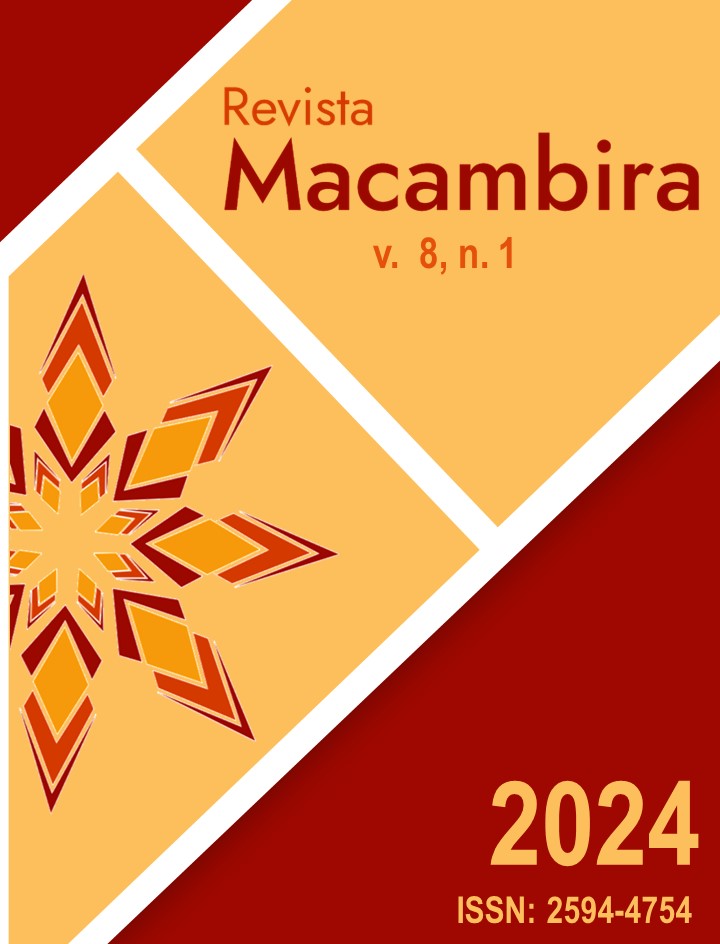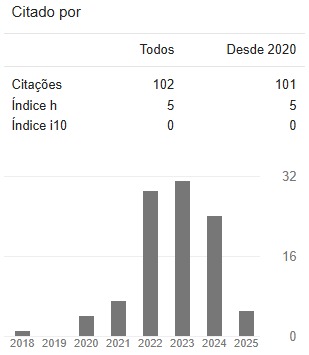Efeito da adubação orgânica na produção de ácidos graxos e atividade antidiabética de Portulaca oleracea L.
DOI:
https://doi.org/10.35642/rm.v8i1.1226Palavras-chave:
Beldroega, ácido alfa-linolênico, ácido linoléico, α-Glucosidase, aditivos orgânicosResumo
Portulaca oleracea L., vulgarmente conhecida como beldroega, é uma planta consumida na Europa, Ásia e África, com compostos nutracêuticos e ácidos gordos essenciais cujo conteúdo excede o de vegetais como espinafre e alface. Por outro lado, a adubação orgânica melhora as características físico-químicas do solo e assim promove o crescimento, a fisiologia e o metabolismo secundário, melhorando a composição química da planta. Para avaliar o efeito da adubação orgânica no teor de ácidos graxos e na atividade antidiabética (α-Glucosidase), plantas cultivadas em casa de vegetação foram submetidas a três tratamentos: controle sem adubação adicional, com composto e vermicomposto. Os resultados indicaram que o vermicomposto aumentou significativamente o teor de ácido oleico e linoléico. Entretanto, o teor de ácido palmítico diminuiu, embora outros ácidos graxos saturados, como os ácidos láurico, mirístico e esteárico, não tenham apresentado variações nos diferentes tratamentos. Dos ácidos graxos essenciais poliinsaturados, o ácido linolênico (ômega-3) aumentou no tratamento de controle. Por outro lado, a enzima α-Glucosidase não apresentou diferenças nos diferentes tratamentos de fertilização. Contudo, a sua elevada percentagem de inibição (60 %) posiciona-a como uma espécie com elevado potencial antidiabético.
Downloads
Referências
AGROMETEOROLOGÍA. INIA. 2022. Disponível em: https://agrometeorologia.cl/RD. Acesso em: 13 mai. 2023.
ARIF, M. S. et al. Nitrogen‐enriched compost application combined with plant growth‐promoting rhizobacteria (PGPR) improves seed quality and nutrient use efficiency of sunflower. Journal of Plant Nutrition and Soil Science, v. 180, n. 4, p. 464–473, ago. 2017. DOI: https://doi.org/10.1002/jpln.201600615.
CHEN, Y.; MEESAPYODSUK, D.; QIU, X. Transgenic production of omega-3 very long chain polyunsaturated fatty acids in plants: Accomplishment and challenge. Biocatalysis and Agricultural Biotechnology, Trait Introduction Methods and Innovation Platforms in Plant Biotechnology. v. 3, n. 1, p. 38–43, 1 jan. 2014. DOI: https://doi.org/10.1016/j.bcab.2013.08.007.
CORAL CAYCHO, E. R.; CALIXTO COTOS, M. R.; SOBERÓN LOZANO, M. M. Actividad inhibitoria in vitro de los extractos acuosos de los frutos de Hylocereus megalanthus y Passiflora tripartita var. mollisima sobre las enzimas α-amilasa y α-glucosidasa. Revista de la Sociedad Química del Perú, v. 86, n. 2, p. 93–104, 30 jun. 2020. DOI: http://dx.doi.org/10.37761/rsqp.v86i2.279.
COSTAMAGNA, M. S. et al. Polyphenols rich fraction from Geoffroea decorticans fruits flour affects key enzymes involved in metabolic syndrome, oxidative stress and inflammatory process. Food Chemistry, v. 190, p. 392–402, jan. 2016. DOI: https://doi.org/10.1016/j.foodchem.2015.05.068.
CREWS, C. et al. Study of the main constituents of some authentic walnut oils. Journal of Agricultural and Food Chemistry, v. 53, n. 12, p. 4853–4860, 1 jun. 2005. DOI: https://doi.org/10.1021/jf0478354.
DI RIENZO, J.A. et al. InfoStat, Versión 2013. Grupo InfoStat, FCA; Universidad Nacional de Córdoba, 2013. Disponível em: http://www.infostat.com.ar. Acesso em: 13 mai. 2023.
DISCIGLIO, G. et al. Qualitative characterization of cultivated and wild edible plants: mineral elements, phenols content and antioxidant capacity. Italian Journal of Agronomy, v. 11, 1 set. 2017. DOI: https://doi.org/10.4081/ija.2017.1036.
ELZOBAIR, K. A. et al. Contrasting effects of biochar versus manure on soil microbial communities and enzyme activities in an Aridisol. Chemosphere, v. 142, p. 145–152, jan. 2016. DOI: https://doi.org/10.1016/j.chemosphere.2015.06.044.
FOOD AND AGRICULTURE ORGANIZATION OF THE UNITED NATIONS (FAO). Transforming Food Systems: Pathways for Country-led Innovation. 2022. Disponível em: https://www3.weforum.org/docs/WEF_Transformig_Food_System_2022.pdf. Acesso em: 10 mai. 2023.
GUNENC, A. et al. Portulaca oleracea seeds as a novel source of alkylresorcinols and its phenolic profiles during germination. LWT, v. 101, p. 246–250, mar. 2019. DOI: https://doi.org/10.1016/j.lwt.2018.10.075.
HAN, L. et al. Inhibition mechanism of α-glucosidase inhibitors screened from Tartary buckwheat and synergistic effect with acarbose. Food Chemistry, v. 420, p. 136102, set. 2023. DOI: https://doi.org/10.1016/j.foodchem.2023.136102.
HAN, L. et al. Proanthocyanidin B 2 attenuates postprandial blood glucose and its inhibitory effect on alpha-glucosidase: analysis by kinetics, fluorescence spectroscopy, atomic force microscopy and molecular docking. Food & Function, v. 9, n. 9, p. 4673–4682, 2018. DOI: https://doi.org/10.1039/C8FO00993G.
HOZAYEN W.; BASTAWY, M.; ELSHAFEEY, H. Effects of aqueous purslane (Portulaca Oleracea) extract and fish oil on gentamicin nephrotoxicity in albino rats. Nature and Science, v. 9, n. 2, p. 47-62, 2011: Available: https://www.researchgate.net/publication/303910661_Effects_of_Aqueous_Purslane_Portulaca_Oleracea_Extract_and_Fish_Oil_on_Gentamicin_Nephrotoxicity_in_Albino_Rats. Accesssed on: 2 mai. 2022
IRANSHAHY, M. et al. A review of traditional uses, phytochemistry and pharmacology of Portulaca oleracea L. Journal of Ethnopharmacology, v. 205, p. 158–172, jun. 2017. DOI: https://doi.org/10.1016/j.jep.2017.05.004.
KAHLE, D.; WICKHAM, H. Ggmap: spatial visualization with ggplot2. The R Journal, v. 5, n. 1, p. 144–161, 2013. Available: https://journal.r-project.org/archive/2013/RJ-2013-014/index.html. Accesssed on: 2 mai. 2022.
KANBAR, A. et al. Peruvian Amaranth (kiwicha) accumulates higher levels of the unsaturated linoleic acid. International Journal of Molecular Sciences, v. 24, n. 7, p. 6215, 25 mar. 2023. DOI: https://doi.org/10.3390/ijms24076215.
KONONOVA, M. Soil organic matter. Soil Organic Matter: Its Nature, Its Role in Soil Formation and in Soil Fertility. 2nd ed. Pergamon Press, p. 183-228, 1996. Available: https://www.sciencedirect.com/book/9780080114705/soil-organic-matter. Accesssed on: 3 mai. 2022.
KUMAR, A. et al. A review on bioactive phytochemicals and ethnopharmacological potential of purslane (Portulaca oleracea L.). Heliyon, v. 8, n. 1, p. e08669, jan. 2022. DOI: https://doi.org/10.1016/j.heliyon.2021.e08669.
LAN, S.; FU-ER, L. Effects of Portulaca oleracea on insulin resistance in rats with type 2 diabetes mellitus. Chinese Journal of Integrative Medicine, v. 9, n. 4, p. 289–292, dez. 2003. DOI: https://doi.org/10.1007/BF02838618.
LEE, A. S. et al. Portulaca oleracea ameliorates diabetic vascular inflammation and endothelial dysfunction in db/db mice. Evidence-Based Complementary and Alternative Medicine, v. 2012, p. 1–9, 2012. DOI: https://doi.org/10.1155/2012/741824.
LEONTI, M. The co-evolutionary perspective of the food-medicine continuum and wild gathered and cultivated vegetables. Genetic Resources and Crop Evolution, v. 59, n. 7, p. 1295–1302, out. 2012. DOI: https://doi.org/10.1007/s10722-012-9894-7.
LI, Y. Q. et al. Comparative evaluation of quercetin, isoquercetin and rutin as inhibitors of α-glucosidase. Journal of Agricultural and Food Chemistry, v. 57, n. 24, p. 11463–11468, 23 dez. 2009. DOI: https://doi.org/10.1021/jf903083h.
LIU, L. et al. Fatty acids and β-carotene in Australian purslane (Portulaca oleracea) varieties. Journal of Chromatography A, v. 893, n. 1, p. 207–213, set. 2000. DOI: https://doi.org/10.1016/S0021-9673(00)00747-0.
MEJRI, F. et al. Phytochemical analysis and in vitro and in vivo evaluation of biological activities of artichoke (Cynara scolymus L.) floral stems: Towards the valorization of food by-products. Food Chemistry, v. 333, p. 127506, dez. 2020. DOI: https://doi.org/10.1016/j.foodchem.2020.127506.
MONTOYA-GARCÍA, C. O. et al. Change in the contents of fatty acids and antioxidant capacity of purslane in relation to fertilization. Scientia Horticulturae, v. 234, p. 152–159, abr. 2018. DOI: https://doi.org/10.1016/j.scienta.2018.02.043.
OLIVEIRA, I. et al. Phytochemical characterization and radical scavenging activity of Portulaca oleraceae L. leaves and stems. Microchemical Journal, v. 92, n. 2, p. 129–134, jul. 2009. DOI: https://doi.org/10.1016/j.microc.2009.02.006.
PÁEZ, A. et al. Crecimiento, carbohidratos solubles y ácidos grasos de verdolaga (Portulaca oleracea L.) sometida a tres niveles de radiación. Revista de la Facultad de Agronomía, v. 24, n. 4, p. 642-660, 2007. Available: https://ve.scielo.org/scielo.php?script=sci_arttext&pid=S0378-78182007000400003. Accesssed on: 10 mai. 2022.
PARDO-DE-SANTAYANA, M. et al. Traditional knowledge of wild edible plants used in the northwest of the Iberian Peninsula (Spain and Portugal): a comparative study. Journal of Ethnobiology and Ethnomedicine, v. 3, n. 1, p. 27, dez. 2007. DOI: https://doi.org/10.1186/1746-4269-3-27.
PETROPOULOS, S. et al. Phytochemical composition and bioactive compounds of common purslane (Portulaca oleracea L.) as affected by crop management practices. Trends in Food Science & Technology, v. 55, p. 1–10, set. 2016. DOI: https://doi.org/10.1016/j.tifs.2016.06.010.
PINTO-MORALES, F. et al. The use of compost increases bioactive compounds and fruit yield in Calafate grown in the Central South of Chile. Agriculture, v. 12, n. 1, p. 98, 11 jan. 2022. DOI: https://doi.org/10.3390/agriculture12010098.
RAWSTHORNE, S. Carbon flux and fatty acid synthesis in plants. Progress in Lipid Research, v. 41, n. 2, p. 182–196, mar. 2002. DOI: https://doi.org/10.1016/S0163-7827(01)00023-6.
ROMERO, P.; FERNÁNDEZ-FERNÁNDEZ, J. I.; MARTINEZ-CUTILLAS, A. Physiological thresholds for efficient regulated deficit-irrigation management in winegrapes grown under semiarid conditions. American Journal of Enology and Viticulture, v. 61, n. 3, p. 300–312, set. 2010. DOI: https://doi.org/10.5344/ajev.2010.61.3.300.
ROMO-PÉREZ, A. et al. Phytochemical study of Eryngium cymosum F. delaroche and the inhibitory capacity of its main compounds on two glucose-producing pathway enzymes. Plants, v. 11, n. 7, p. 992, 5 abr. 2022. DOI: https://doi.org/10.3390/plants11070992.
RSTUDIO. RStudio: Integrated Development for R; RStudio, Inc.: Boston, MA, USA. v. 42, p. 84, 2015. Disponível em: http://www.rstudio.com. Acesso em: 5 mai. 2022.
SERRA, J. L. et al. Alternative sources of oils and fats from Amazonian plants: Fatty acids, methyl tocols, total carotenoids and chemical composition. Food Research International, v. 116, p. 12–19, fev. 2019. DOI: https://doi.org/10.1016/j.foodres.2018.12.028.
SINGH, R. P. et al. Chapter 2 - Biotechnological Tools to Enhance Sustainable Production. In.: SINGH, R. L.; MONDAL, S. (Eds.). Biotechnology for Sustainable Agriculture. [s.l.] Woodhead Publishing, 2018. p. 19–66. Available: https://www.sciencedirect.com/science/article/abs/pii/B9780128121603000027. Accesssed on: 10 mai. 2022.
SORRENTI, G.; MUZZI, E.; TOSELLI, M. Root growth dynamic and plant performance of nectarine trees amended with biochar and compost. Scientia Horticulturae, v. 257, p. 108710, nov. 2019. DOI: https://doi.org/10.1016/j.scienta.2019.108710.
STOLPE, B.N. Descripciones de los principales suelos de la VIII Región de Chile. Departamento de Suelos y Recursos Naturales. N° 01. Trama Impresores S.A. Publicaciones. 2006. Disponível em: https://hdl.handle.net/20.500.14001/56740. Acesso em: 13 maio 2023.
TAKAHASHI, M.; SAKATA, T.; ISHIZUKA, K. Chemical characteristics and acid buffering capacity of surface soils in japanese forests. Water, Air, and Soil Pollution, v. 130, n. 1/4, p. 727–732, 2001. Available: https://link.springer.com/article/10.1023/A:1013885518767. Accesssed on: 10 mai. 2022.
UDDIN, MD. K. et al. Purslane weed (Portulaca oleracea): a prospective plant source of nutrition, omega-3 fatty acid, and antioxidant attributes. The Scientific World Journal, v. 2014, p. 1–6, 2014. DOI: https://doi.org/10.1155/2014/951019.
VERARDO, V. et al. Effect of nitrogen fertilisation rates on the content of fatty acids, sterols, tocopherols and phenolic compounds, and on the oxidative stability of walnuts. LWT - Food Science and Technology, v. 50, n. 2, p. 732–738, mar. 2013. DOI: https://doi.org/10.1016/j.lwt.2012.07.018.
VITALINI, S. et al. Phenolic compounds from Achillea millefolium L. and their bioactivity. Acta Biochimica Polonica, v. 58, n. 2, 19 abr. 2011. Available: https://pubmed.ncbi.nlm.nih.gov/21503279/. Accesssed on: 10 mai. 2022.
WAINSTEIN, J. et al. Purslane extract and glucose homeostasis in adults with type 2 diabetes: a double-blind, placebo-controlled clinical trial of efficacy and safety. Journal of Medicinal Food, v. 19, n. 2, p. 133–140, fev. 2016. DOI: https://doi.org/10.1089/jmf.2015.0090.
WANG, S. Y.; LIN, H.-S. Compost as a soil supplement increases the level of antioxidant compounds and oxygen radical absorbance capacity in strawberries. Journal of Agricultural and Food Chemistry, v. 51, n. 23, p. 6844–6850, 1 nov. 2003. DOI: https://doi.org/10.1021/jf030196x.
WANG, W. et al. Protective effect of Portulaca oleracea extracts on hypoxic nerve tissue and its mechanism. Asia Pacific Journal of Clinical Nutrition, v. 16 Suppl 1, p. 227–233, 2007. Available: https://pubmed.ncbi.nlm.nih.gov/17392109/. Accesssed on: 10 mai. 2022.
XIAO, J. et al. Advance in dietary polyphenols as α-glucosidases inhibitors: a review on structure-activity relationship aspect. Critical Reviews in Food Science and Nutrition, v. 53, n. 8, p. 818–836, jan. 2013. DOI: https://doi.org/10.1080/10408398.2011.561379.
XIN, H. et al. α-linolenic acid and linoleic acid in extract of Portulaca oleracea L. determined by high-performance liquid chromatography. Zhong Xi Yi Jie He Xue Bao = Journal of Chinese Integrative Medicine, v. 6, n. 11, p. 1174–1177, nov. 2008. DOI: https://doi.org/110.3736/jcim20081113.
YAN, J. et al. Homoisoflavonoids from the medicinal plant Portulaca oleracea. Phytochemistry, v. 80, p. 37–41, ago. 2012. DOI: https://doi.org/10.1016/j.phytochem.2012.05.014.
ZHOU, Y.-X. et al. Portulaca oleracea L.: a review of phytochemistry and pharmacological effects. BioMed Research International, v. 2015, p. 1–11, 2015. DOI: https://doi.org/10.1155/2015/925631.
ZHOU, Z. et al. Effects of organic fertilizer incorporation practices on crops yield, soil quality, and soil fauna feeding activity in the wheat-maize rotation system. Frontiers in Environmental Science, v. 10, p. 1058071, 17 nov. 2022. DOI: https://doi.org/10.3389/fenvs.2022.1058071.
Downloads
Publicado
Edição
Seção
Licença
Copyright (c) 2024 Revista Macambira

Este trabalho está licenciado sob uma licença Creative Commons Attribution 4.0 International License.












